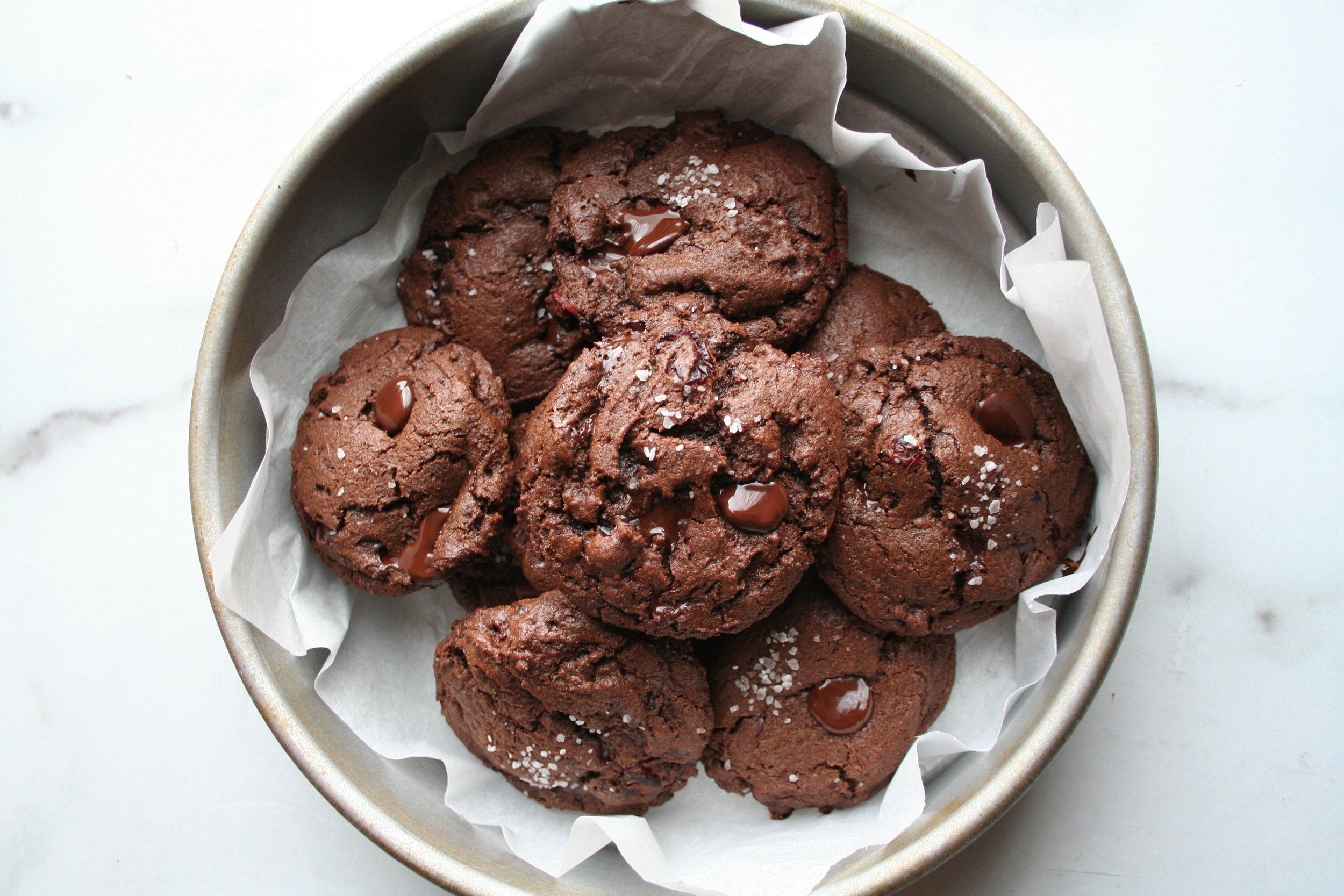Double Chocolate Craisin Cookies
The question is not how but why the cookie crumbles
How do I know I’m getting old? I now enjoy dried fruit with my chocolate. As a child, I used to get a kick out of Terry’s chocolate oranges—but it was a rule-proving exception. Dried fruits and nuts were welcome in trail mix, sure, as long as the M&M ratio was sufficient. But when it came to cookies, I drew a hard line. For in my child’s mind the Kingdom of Cookiedom had an obvious hierarchy, a crowned chocolate chip cookie reigning benevolently over various duchies. All of these courtly figures—from the exotically spiced ginger snap to the sentimental, dimwitted sugar cookie, to my favorite court jester, the snickerdoodle—were welcome in my home and its cookie jar. But there was a pretender to the throne. A sniveling look-alike, always slinking around, dressed in exactly what the King had worn the day before.
What child hasn’t been hoodwinked by a food doppelganger? Children are duped all the time. My life so far as a parent is a taxonomy of lies: from benign fibs all the way up through reindeer-pulled whoppers. But surely no lie ever left so indelible an impression on my own psyche as the one broadcast by a familiar looking treat, which was in truth an imposter: an oatmeal raisin cookie.
As an adult, I love oatmeal raisin cookies. I mean, I never bake them. Or reach for them if there are other options. But I’ve made peace with them. I’ve softened my dried fruit policy and granted titles (and cookie jar acreage) to many new cookies. The chocolate chip is still the “cookie” that springs to mind at that word’s utterance—like Queen Elizabeth II for “British monarch.” I delight, however, in the cookie Grand Prix. I bake them all joyfully, giving each its due. Those other cookies jockey for pole position in a race they are sure to lose. Rising swiftly in the melee is a deep chocolate newcomer, a pink twinkle in the ebony pools of its eyes. Behold: the double chocolate craisin cookie.
There is a nasty superstition that hovers, grandmotherly, over recipes for baked goods. “Cooking is an art. Baking is a science.” This cliché does a poor job of explaining any of the multitude of differences in sweet and savory cooking—both of which involve art and science. But one needn’t be a chemist in order to experiment in the kitchen. Just read this article. In it, Kenji Lopez-Alt, a food (journalism) luminary, details the role each cookie ingredient plays. I kept all of this in mind as I compared recipes for double chocolate cookies and considered my own intentions. I knew I wanted cranberry, for its chromatic and textural intrigue just as much as its tartness. I figured that, since craisins are a relatively low moisture ingredient, their addition wouldn’t affect the cookie’s structural integrity. I knew I wanted a mix of brown and granulated sugars for balance. I thought plenty of cocoa powder (for its deep, bitter cacao flavor) as well as a high-quality dark bar would give the full chocolate effect. By a survey of the cookie recipes on my bookshelf and those floating to the top of a quick Google search, I was able to triangulate quantities for a leavening agent, flour, butter and egg.
Over the counter cookies, available on the shelves of your local grocery store, are great. But the good stuff is available only with a recipe. Look, I have no bone to pick with so-called processed foods. They serve a minimal role in my own kitchen and diet but they do so serviceably. I do believe that researching every ingredient—whether on a package of prepared food or in a recipe—changes your relationship with food for the better. Regardless of how you proceed from that encounter, knowledge empowers the decision. But the superiority of making your own food, the nutritional and psychological benefits, are self-evident.
Cookies, and these cookies especially, are an indulgent food. But the problem with indulgent foods isn’t a categorical one. Through ease of access and the incredibly low cost of commercial products, their specialness has dissipated. The notion of specialness itself, of “dessert,” has lost its temporal dimension. Dessert, literally meaning the “removal of what has been served,” is best understood as that enchanted condition belonging to the end of a lovely meal, the bittersweet imminence of parting. It’s like a great encore performance after the band has walked off stage and taken their equipment.
A cookie is a veneration of the time it took to make it, not something to mindlessly munch while you use that time “productively.” A cookie is a celebration of the act of cooking for oneself, one’s companions or one’s family. The cookie is not, itself, the reward. But neither is the act of making the cookie. The reward arrives by contradiction: it is both, and neither. You gain the cookie by losing it. This is the contradiction at the heart of all cooking. If you do a good job, nothing but crumbs and memories remain.
DOUBLE CHOCOLATE CRAISIN COOKIES
Ingredients
· ½ cup unsalted butter, room temperature
· ½ cup granulated sugar
· ½ cup brown sugar
· 1 egg, room temperature
· 2 tsp. vanilla extract
· ½ cup cocoa powder
· 1 cup all-purpose flour
· ½ teaspoon baking soda
· ½ teaspoon salt
· 2/3 cup chopped dark chocolate
· 2/3 cup craisins
Instructions
Preheat the oven to 350°F and line a baking sheet with parchment paper.
Place the softened butter, granulated sugar, and brown sugar in a stand mixer fitted with the paddle attachment. Beat on medium high speed until fluffy, about 2 minutes.
Scrape down the sides of the bowl and add the egg and vanilla extract. Mix until combined.
Scrape down the bowl and add the cocoa powder, flour, baking soda and salt. Mix on low speed to start, then increase to medium. Mix until just combined
Add chopped chocolate and craisins, mix until incorporated.
Portion dough with a 2 ounce cookie scoop and arrange on your prepared cookie sheet 2 inches apart.
Bake at 350°F for 11 minutes or until the edges are set but the centers are still gooey. Allow to cool for 10 minutes before enjoying.








